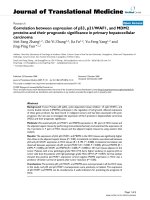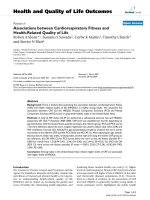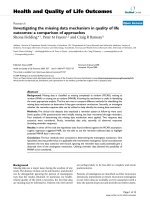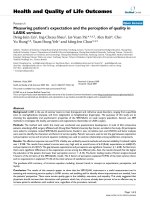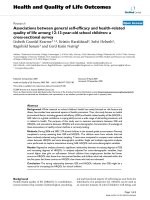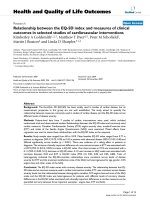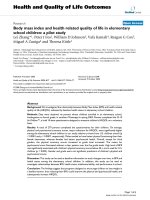báo cáo hóa học: " Associations between general self-efficacy and health-related quality of life among 12-13-year-old school children: a cross-sectional survey" potx
Bạn đang xem bản rút gọn của tài liệu. Xem và tải ngay bản đầy đủ của tài liệu tại đây (279.59 KB, 8 trang )
BioMed Central
Page 1 of 8
(page number not for citation purposes)
Health and Quality of Life Outcomes
Open Access
Research
Associations between general self-efficacy and health-related
quality of life among 12-13-year-old school children: a
cross-sectional survey
Lisbeth Gravdal Kvarme*
1,4
, Kristin Haraldstad
2
, Sølvi Helseth
2
,
Ragnhild Sørum
3
and Gerd Karin Natvig
4
Address:
1
Diakonova University College, Linstowsgate 5, N-0166 Oslo, Norway,
2
Oslo University College, Pilestredet 46, N-0167 Oslo, Norway,
3
Cancer Registry of Norway, Postboks 5313 Majorstuen, N-0340 Oslo, Norway and
4
Department of Public Health and Primary Care, University
of Bergen, Kalfarveien 31, N-5018 Bergen, Norway
Email: Lisbeth Gravdal Kvarme* - ; Kristin Haraldstad - ;
Sølvi Helseth - ; Ragnhild Sørum - ; Gerd Karin Natvig -
* Corresponding author
Abstract
Background: While research on school children's health has mainly focused on risk factors and
illness, few studies have examined aspects of health promotion. Thus, this study focuses on health
promotional factors including general self-efficacy (GSE) and health-related quality of life (HRQOL).
GSE refers to a global confidence in coping ability across a wide range of demanding situations, and
is related to health. The purpose of this study was to examine associations between GSE and
HRQOL, and associations between HRQOL and socio-demographic characteristics. Knowledge of
these associations in healthy school children is currently lacking.
Methods: During 2006 and 2007, 279 school children in the seventh grade across eastern Norway
completed a survey assessing their GSE and HRQOL. The children were from schools that had
been randomly selected using cluster sampling. T-tests were computed to compare mean subscale
values between HRQOL and socio-demographic variables. Single and multiple regression analyses
were performed to explore associations among GSE, HRQOL and socio-demographic variables.
Results: Regression analyses showed a significant relationship between increasing degrees of GSE
and increasing degrees of HRQOL. In analyses adjusted for socio-demographic variables, boys
scored higher than girls on self-esteem. School children from single-parent families had lower
scores on HRQOL than those from two-parent families, and children who had relocated within the
last five years had lower scores on HRQOL than those who had not relocated.
Conclusion: The strong relationship between GSE and HRQOL indicates that GSE might be a
resource for increasing the HRQOL for school children.
Background
Health-related quality of life (HRQOL) is a multidimen-
sional construct that consists of physiological, psycholog-
ical and functional aspects of well-being as seen from the
individual's own perspective [1]. HRQOL can be used as
an outcome measure of school children's well-being, and
Published: 23 September 2009
Health and Quality of Life Outcomes 2009, 7:85 doi:10.1186/1477-7525-7-85
Received: 29 April 2009
Accepted: 23 September 2009
This article is available from: />© 2009 Kvarme et al; licensee BioMed Central Ltd.
This is an Open Access article distributed under the terms of the Creative Commons Attribution License ( />),
which permits unrestricted use, distribution, and reproduction in any medium, provided the original work is properly cited.
Health and Quality of Life Outcomes 2009, 7:85 />Page 2 of 8
(page number not for citation purposes)
for developing methods to promote health [2]. The con-
cept of health promotion comprises active support of the
physical, social and mental well-being of individuals
[3,4]. Schools are important settings for health promotion
for children [5,6]. Research has thus far mainly focused on
symptoms and problems [7,8]. Therefore, more research
on HRQOL and psychosocial factors that may enhance
the well-being of school children is needed. The concept
of self-efficacy is suggested as one such focus. Introduced
by Albert Bandura, it represents one core aspect of his
social cognitive theory [9]. Self-efficacy comprises both
general and domain-specific measures. General self-effi-
cacy (GSE) is the belief in one's competence to attempt
difficult or novel tasks, and to cope with adversity arising
from specific demanding situations [10-12]. It makes a
difference to how people feel, think and act [9]. The con-
struct of GSE reflects an optimistic self-belief [13], and
refers to a global confidence in coping abilities across a
wide range of demanding situations [13].
According to social cognitive theory [9], human motiva-
tions and actions are regulated extensively by forethought.
The prime factor for influencing behaviour is perceived
self-efficacy [11]. Self-efficacy is the foundation of human
motivation, well-being and accomplishment. Perceived
self-efficacy can be characterized as being competence
based, prospective, and action related [9].
According to Bandura [9], self-efficacy is context depend-
ent and assessment methods must be tailored to each
event or research setting. However, other researchers have
proposed the concept of general self-efficacy and have
constructed a general self-efficacy scale for use in several
settings [14]. The essential idea behind this concept is that
self-efficacy can be of a general character or a universal
construct [15], and can be used in a wide range of situa-
tions.
Previous studies have found that a high degree of GSE is
related to high self-belief [9,16] and an optimistic outlook
on life [13,17]. An overview of the literature shows that
positive associations between GSE and HRQOL
[12,18,19] as well as domain-specific self-efficacy [10,20-
23] were found among adults with diseases. Only one
study among adolescents focused on associations
between self-efficacy and life satisfaction. While they are
superficially similar, life satisfaction and HRQOL are not
the same concept [24]. This study found a positive associ-
ation between the domain-specific self-efficacy concept
(measured as family self-efficacy and peer self-efficacy)
and perceived life satisfaction (measured by variables
such as family life, friends, school, community, financial
status, and material possessions). Additionally, a rela-
tively new study [25] has found that stress-related coping
was a significant predictor for quality of life among chil-
dren with asthma.
In addition to the direct and positive association between
self-efficacy and different health outcomes, Bandura [9]
has suggested that self-efficacy might function as a media-
tor between stress experience and negative health and
well-being outcomes.
No previous studies have explored associations between
GSE and HRQOL in healthy school children. The main
aim of this study was to examine the association between
GSE and HRQOL in a sample of Norwegian school chil-
dren, and explore how this association is related to socio-
demographic characteristics. Based on both empirical
research and theory, we hypothesized that increasing
degrees of GSE would be related to increasing degrees of
HRQOL.
Methods
Sample
This study was part of a larger study that had the overall
aim of studying HRQOL among Norwegian school chil-
dren and adolescents aged 8-18 years. Data collection was
carried out from October 2006 to April 2007. The school
children were recruited through schools in a region of
eastern Norway containing about 1.7 million inhabitants
(36% of the total Norwegian population). Statistics Nor-
way drew a cluster sample of 11 randomly selected pri-
mary schools using the following criteria: geographic
spread, rural and urban districts, small and large schools.
The schools were sent a letter of invitation outlining the
study, and were followed up by telephone. Schools that
declined to participate were replaced by other schools
selected according to the same criteria. Children in sev-
enth grade in the selected schools with sufficient compe-
tence in the Norwegian language were included in the
study.
The sample in this study consisted of 444 eligible school
children in seventh grade (age 12-13 years), of whom 279
participated (the response rate was 63%). Eighty-three
children (19%) had forgotten to obtain informed consent
from parents, 41 children (9%) were absent from school
on the day of the study, 30 children (7%) received the
wrong questionnaire, and 11 children (2%) declined to
participate.
Procedure
The school children and their teachers were given verbal
and written information at school by the investigator one
week before the study took place. The children were told
that the purpose of the study was to obtain knowledge
about general quality of life among children and adoles-
cents. They were also informed that their responses would
Health and Quality of Life Outcomes 2009, 7:85 />Page 3 of 8
(page number not for citation purposes)
be treated anonymously, and that there were no right or
wrong answers. The children received an envelope with
standard information about the study, and written con-
sent form for their parents. Approvals signed by parents
and children were returned to the teachers. The school
nurse assisted in the information gathering process and in
the data collection tasks. The self-report instruments were
completed in the classrooms during a school hour, and
the investigator was present and could assist the children
if necessary. Children who were absent from school on
the day of the study were not included.
Measures
HRQOL
The Norwegian translation of the German questionnaire
KINDL was used to measure HRQOL. KINDL is a quality
of life measure developed for use with healthy and clinical
groups of children and adolescents aged 4-16 years. The
questionnaire has been developed as a generic measure.
However, some disease-specific modules are available and
can be added to the generic measure. Only the generic
instrument was used in the present study. The measure-
ment is easy to use, and suitable for use in school health
services. The form consists of 24 Likert-scaled items
equally divided into six subgroups (physical well-being,
emotional well-being, self-esteem, family, friends and
school). Each item refers to experiences over the past week
and is rated on a five-point scale (1 = Never, 2 = Seldom,
3 = Sometimes, 4 = Often and 5 = Always). Mean scores
are calculated for each of the six subscales and for the total
scale, and linearly transformed to a 0-100 scale.
KINDL has satisfactory reliability and validity, and its psy-
chometric properties have been tested in several countries
including Norway [3]. Cronbach's α was from 0.53 to
0.78 for the subscales, and 0.82 for the total scales in the
Norwegian study [3], and 0.70 and higher for the sub-
scales and 0.80 for the total scale in other studies [1,26].
Correlations with comparable well-being scales have
shown acceptable convergent validity and a high correla-
tion (r >.70) with subscales of the Child Health Question-
naire [27] as well as satisfactory discriminant validity [1].
GSE
GSE refers to global confidence in one's ability across a
wide range of demanding and novel situations [14]. The
Generalized Self-Efficacy Scale is a 10-item psychometric
scale that is designed to assess optimistic self-belief in cop-
ing with a variety of difficult demands in life. The scale
was originally developed in Germany by Matthias Jerusa-
lem and Ralf Schwarzer in 1981 and has been used in many
studies with hundreds of thousands of participants [14].
The scale was created to assess a general sense of perceived
self-efficacy, with the aim in mind of predicting ability to
cope with daily demands as well as adaptation after expe-
riencing all kinds of stressful life events. A revised five-
item version of this instrument was used in the present
study [28,29]. The scale is designed for the general adult
population, including adolescents from 12 years old. A
typical item was, "I always manage to solve difficult prob-
lems if I try hard enough." The instrument has a four-
point scale from 1 ("completely wrong") to 4 ("com-
pletely right"). Higher scores refer to higher levels of GSE.
The GSE scale has been found to be reliable and valid in
numerous studies, where the Cronbach's α was between
0.75 and 0.90 [14]. It has also proved valid in terms of
convergent and discriminate validity. It correlates posi-
tively with self-esteem and optimism [14]. Criterion-
related validity is documented in numerous correlation
studies where positive coefficients were found with
favourable emotions, dispositional optimism, and work
satisfaction. Negative coefficients were found with depres-
sion, anxiety, stress, burnout, and health complaints [14].
Ethics
The Regional Committee for Medical Research Ethics for
Western Norway approved the study. Written informed
consent for the participation was obtained from the par-
ents and the children before they could complete the
questionnaires. The children were informed that their
responses would be treated anonymously, and that there
were no right or wrong answers.
Statistical analysis
Descriptive analyses were used to assess the mean and
standard deviation of HRQOL (subscales and total scale)
for socio-demographic variables and GSE (total). Cron-
bach's alpha was computed to assess the reliability of the
questions. T-tests were done to compare mean subscale
values of HRQOL according to groups of socio-demo-
graphic variables. Sociodemographic variables that
showed significant differences for any subscale were
included in the regression analyses. To evaluate the asso-
ciations between HRQOL as a dependent variable, socio-
demographic variables, and GSE as an independent varia-
ble, single and multiple regression analyses were per-
formed.
Regression analyses were performed to evaluate the asso-
ciation between HRQOL, and sociodemographic varia-
bles and GSE. Both single and multiple regression
analyses were performed. In the multiple models, we
included HRQOL as a dependent variable, and gender
(girls versus boys), marital status (two parents married or
cohabiting) versus single parent (unmarried, divorced or
widowed), relocation in the last five years (yes versus no),
mother's birthplace (Norway versus other country), and
GSE as independent variables.
Health and Quality of Life Outcomes 2009, 7:85 />Page 4 of 8
(page number not for citation purposes)
To test for heterogeneity with gender in analyses of rela-
tionships between GSE and HRQOL, an interaction term
was included in the statistical model.
According to the manual, the missing values of HRQOL
and GSE were imputed with the mean of the non-missing
items if the respondent had answered at least 70% of the
items in the actual subscale. HRQOL and GSE were trans-
formed on a scale from 0 to 100. GSE was analysed as a
total score. The p-value of this interaction term was not
significant, and the regression analyses were therefore per-
formed with both genders combined. A p-value less than
or equal to 0.05 was considered statistically significant. All
analyses were conducted using SPSS Version 15 for Win-
dows (SPSS Inc., Chicago, Illinois).
Results
Mean scores and Cronbach's alpha
As seen in Table 1, a total of 279 school children answered
the questionnaire; 152 (55%) girls and 127 (45%) boys,
all in seventh grade. The school children in the present
study were 12-13 years old. Results from all the subscales
and total scale in HRQOL are presented in Table 2. The
total mean score for HRQOL was 72.6, and the total mean
score for GSE was 67.7; by gender, 66.3 for girls and 69.4
for boys. Reliability is expressed by Cronbach's α, where
the overall value for HRQOL was 0.82. In the present
study, the internal consistency of the Norwegian KINDL
friends and school subscale showed the lowest alpha,
while the self-esteem subscale showed the highest values.
Cronbach's α for GSE was 0.79.
Socio-demographic variables
Additional file 1 shows mean values for the subscales of
HRQOL according to sociodemographic variables. The
only significant difference between boys and girls was for
self-esteem, where boys reported higher scores than girls.
The marital status variable showed that children with a
single parent had lower scores on all subscales and totals
compared to those with two parents. Respondents who
had relocated in the previous five years had lower scores
on the subscales and total HRQOL. Those children whose
mothers came from a country other than Norway had sig-
nificantly higher scores on the subscales for self-esteem
and family. The highest mean score was on the subscale
emotional well-being for respondents with two parents
(80.4), while the lowest score was observed for self-
esteem for respondents with single parents (56.7).
Regression analyses of socio-demographic variables, GSE
and HRQOL
Results from single and multiple regression analyses of
socio-demographic variables, GSE and HRQOL are pre-
sented in Additional files 2 and 3. The findings from
regression analyses show that boys had significantly
higher scores on self-esteem than girls. Respondents with
a single parent had negative coefficients in all the sub-
scales, and significantly lower scores on emotional well-
being and total HRQOL score compared with those with
two parents. School children who reported having relo-
cated in the last five years had negative coefficients in all
the subscales, and significantly lower scores on family
compared with those who had not relocated. Participants
whose mothers were born in a country other than Norway
had significantly higher scores on the subscales for self-
esteem and family on HRQOL compared with children
with a Norwegian mother. No significant differences were
found for the school children's fathers' country of origin.
Results from linear regression analyses of GSE and
HRQOL showed that increasing degrees of GSE are signif-
icantly related to an increasing degree of HRQOL in all
analyses, both adjusted and unadjusted. The strongest
association for GSE is the subscale for self-esteem and the
school score.
Discussion
The main finding from the present study is that GSE was
significantly and positively associated with HRQOL in
healthy school children. An increasing degree of GSE was
related to an increasing degree of HRQOL for all subscales
and total scales of HRQOL. This result was consistent for
both boys and girls. The strongest association was for self-
esteem, but even physical well-being was significantly,
albeit weakly associated. Respondents with a single parent
had lower scores on the emotional well-being subscale
Table 1: Sociodemographic characteristics of seventh-grade
school children (n = 279)
Characteristic n %
Gender
Girls 152 55
Boys 127 45
Marital status
Two parents 192 70
Single parent 84 30
Unknown 3
Mother's birthplace
Norway 235 84
Other country 40 14
Unknown 6 2
Father's birthplace
Norway 232 83
Other country 42 15
Unknown 5 2
Relocated in last 5 years
No 182 66
Yes 94 34
Unknown 3
Health and Quality of Life Outcomes 2009, 7:85 />Page 5 of 8
(page number not for citation purposes)
and the total HRQOL score compared with those who had
two parents.
This research on HRQOL was based on school children's
subjective perspective, and refers to individual internal
judgments about quality of life experience as opposed to
problems, symptoms or diagnoses. HRQOL is a positive
phenomenon in which the school children report their
life satisfaction. This phenomenon is relative, and can be
influenced by individual needs and expectations [2]. The
present study found almost the same value in the sub-
scales of HRQOL as a prior study in Norway [3,30,31].
The highest mean score was for emotional well-being, fol-
lowed by friends and family, and the lowest score was for
self-esteem [3,30,31].
As in previous research [30-33], the present study found
that boys reported higher scores in the self-esteem sub-
scale than girls. Other studies that have explored gender
differences on self-esteem with other instruments (Rosen-
berg Self-esteem scale and Harter Self-esteem scale) have
shown that girls had lower self-esteem than boys [33,34].
Self-efficacy and self-esteem have shown similarities.
Luszynska et al. [11] found that optimism, self-regulation
and self-esteem had the highest positive association with
self-efficacy [11]. Self-esteem refers to a conviction about
one's worth, whereas the concept of self-efficacy pertains
to judgments of one's personal ability to act [9].
School children who reported that they lived with a single
parent had a lower score on HRQOL in emotional well-
being and total HRQOL than those who lived with two
parents. Other studies on quality of life [35] and life satis-
faction [24] have showed that children living with a single
parent had lower scores on quality of life than those living
with two parents.
As with earlier research on adults [10,13,18,22], the
strongest positive association in the present study was
between GSE and HRQOL. Leganger et al. [36] found sig-
nificant positive correlations between GSE scale and life
satisfaction among adults. Previous studies have found
that GSE predicts health outcomes [11,37,38], happiness
[16], optimism, hope and well-being [17]. A strong sense
of GSE was also related to higher achievement and better
social integration [9,15]. One study explored the relation-
ships between GSE and well-being among adults in five
different countries, and found evidence for positive asso-
ciations between GSE and quality of life and self-esteem
[11]. The only previous study that has explored the rela-
tionship between life satisfaction and self-efficacy among
school children found that self-efficacy beliefs were
related to overall life satisfaction [24].
It was interesting that even physical well-being was posi-
tively correlated with GSE, because physical well-being is
a statement of how the school children reported their
health status, while GSE is a theoretical concept built on
their belief in themselves and their level of optimism.
Other studies among adolescents have found associations
between low physical activity and low self-efficacy [39-
41].
Bandura's social cognitive theory is based on an under-
standing that humans are direct agents in shaping and
responding to environmental conditions. A strong sense
of personal self-efficacy is related to better health [9,15].
The level of self-efficacy varies by age, personal experi-
ences, and differs individually. Pubertal changes contrib-
ute to the development of self-efficacy in interaction with
psychosocial factors. Adolescents must re-establish their
sense of efficacy, social connectedness and network of
new peers and with multiple teachers. During this period
adolescents become less confident [9]. A person who
believes in being able to produce a desired effect can lead
Table 2: Subscale and total scale of Health-Related Quality of Life (HRQOL) and General Self-Efficacy (GSE) among seventh-grade
schoolchildren (n = 279)
n Mean Standard deviation No. items Cronbach's alpha
HRQOL
Physical
wellbeing
273 72.56 17.56 4 0.70
Emotional
wellbeing
275 78.54 15.19 4 0.67
Self-esteem 275 62.37 19.43 4 0.79
Family 275 77.92 17.38 4 0.76
Friends 274 74.45 15.18 4 0.61
School 273 70.03 16.93 4 0.61
Total scale 265 72.66 12.38 24 0.82
GSE 275 67.70 19.69 5 0.79
All the scales are transformed to 0 100.
Health and Quality of Life Outcomes 2009, 7:85 />Page 6 of 8
(page number not for citation purposes)
a more active and self-determined life. The belief of 'can
do' cognition is a sense of control over one's environment
[12]. A high level of self-efficacy is related to positive emo-
tions and effective problem solving [9]. High self-efficacy
beliefs are also related to life satisfaction. Therefore, qual-
ity of life is high in self-efficacious individuals [11]. Cice-
rone et al. [20] found that perceived GSE was strongly
associated with life satisfaction among adults.
Self-efficacy is a concept that can possibly change, accord-
ing to Bandura [9]. GSE is a characteristic that can be
altered through education programming [10,37]. An opti-
mistic self-belief helps in setting goals, initiating actions
and maintaining motivation [13]. People with a high level
of self-efficacy choose to perform more challenging tasks.
They set themselves higher goals and stick to them [9].
School settings are areas with potential for changes that
can improve school children's health, well-being and self-
efficacy. School staff and health professionals can help
school children set realistic goals with tasks that they are
able to manage, so they can learn from earlier positive
experiences and expect to master tasks in the future. Self-
efficacy and the feeling of being able to achieve certain
goals using one's capacities play fundamental roles in the
health and well-being of school children [9].
Strengths and limitations
Several limitations of this study should be considered
when interpreting the results. The sample size was quite
small, which restricts the number of factors included in
the multivariate testing. The response rate was 63%.
Another limitation is that we have no information about
the school children who did not participate in this study.
We cannot assess whether participants and non-partici-
pants differed in any respect. As the study had a cross-sec-
tional design, we cannot draw any strong practical
implications from it. Moreover, in view of this design, we
can only interpret the results as associations. Although the
applied regression model implicitely defines GSE as an
explanatory factor for HRQOL, a bidirectional effect is
possible. An increase in GSE might result in better
HRQOL, or school children who have better HRQOL
might also score higher on GSE. However, our findings
were consistent with previous theoretical and empirical
work. Bandura [9] also suggested that self-efficacy predicts
better health and well-being.
Further research that uses longitudinal research, rand-
omized control trials (RCT) or other designs is needed to
determine causality. Longitudinal research could examine
this relationship more closely and determine the direction
of the associations found in this study. RCT could be used
in intervention studies to examine whether GSE might be
a predictor of HRQOL for school children. Confounding
by other factors could be a potential problem, in addition
to the general problem of verifying causal relationships.
However, the strong significant relationship between GSE
and HRQOL indicates that the observed associations
could not be completely explained by other factors. A
strength of this study was the randomly selected sample.
The sample was drawn from different schools in eastern
Norway. The school children were all in the seventh grade.
The Norwegian school system is rather homogenous, so
the findings should be similar in other Norwegian popu-
lations in the same age group. Findings from this study
and previous research indicate that the school setting
could have the potential for changes that can improve
HRQOL for school children.
Conclusion
Results from this study showed a strongly positive signifi-
cant association between GSE and HRQOL. Assessing
HRQOL among school children enables school health
services to determine their life conditions, discover threats
to their well-being, and become aware of vulnerable
school children. The hypothesis that we will find positive
relationships between GSE and HRQOL among school
children was confirmed.
School settings are areas with a potential for changes that
can improve school children's self-efficacy and health.
The school is important for children's social and emo-
tional development. Thus, intervention strategies that are
aimed at improving self-efficacy and HRQOL are needed
in schools. More research is needed to determine whether
the school health service should implement interventions
such as discussion groups that aim to help school children
to reach their goals and strengthen their self-efficacy, with
support from school staff, health professionals, family
and peers.
Abbreviations
GSE: General Self-Efficacy; HRQOL: Health-Related Qual-
ity of Life; KINDL: Kinder Lebensqualität Fragebogen
(German Language Questionnaire for Measuring Health-
Related Quality of Life in Children and Adolescents);
SPSS: Statistical Software Package for the Social Sciences;
WHO: World Health Organization.
Competing interests
The authors declare that they have no competing interests.
Authors' contributions
LGK contributed to the study design, data collection, sta-
tistical analysis, interpretation of data and drafting of the
paper. KH contributed to data collection and revision of
the manuscript. SH contributed to the study design, statis-
tical analysis, interpretation of data and revision of the
manuscript. RS contributed to statistical analysis, inter-
pretation of data and revision of the manuscript. GKN
Health and Quality of Life Outcomes 2009, 7:85 />Page 7 of 8
(page number not for citation purposes)
contributed to the study design, statistical analysis, inter-
pretation of data and revision of the manuscript. All
authors read and approved the final manuscript.
Additional material
Acknowledgements
This study was funded by Diakonova University College, Oslo, and Oslo
University College. We wish to thank all the school children who partici-
pated in the study, and all teachers and school nurses who helped to collect
the data for this study.
References
1. Ravens-Sieberer U, Bullinger M: Assessing health-related quality
of life in chronically ill children with the German KINDL: first
psychometric and content analytical results. Qual Life Res
1998, 5:399-407.
2. Helseth S, Lund T, Christophersen KA: Health-related quality of
life in a Norwegian sample of healthy adolescents: some psy-
chometric properties of CHQ-CF87-N in relation to KINDL-
N. J Adolesc Health 2006, 38:416-425.
3. Helseth S, Lund T: Assessing health-related quality of life in
adolescents: some psychometric properties of the first Nor-
wegian version of KINDL. Scan J Car Scienc 2005:102-109.
4. Ravens-Sieberer U, Gosch A, Abel T, Auquier P, Bellach BM, Bruil J,
et al.: Quality of life in children and adolescents: a European
public health perspective. Soz Praventivmed 2001, 46:294-302.
5. Mansour ME, Kotagal U, Rose B, Ho M, Brewer D, Roy-Chaudhury A,
et al.: Health-related quality of life in urban elementary
schoolchildren. Pediatrics 2003, 111:1372-1381.
6. World Health Organisation: Creating an Environment for Emo-
tional and Social Well-Being An important responsibility of
Health-Promoting and Child Friendly School. 2003.
7. Haugland S, Wold B, Stevenson J, Aaroe LE, Woynarowska B: Sub-
jective health complaints in adolescence. A cross-national
comparison of prevalence and dimensionality. European Jour-
nal of Public Health 2001, 11:4-10.
8. Natvig GK, Albrektsen G, Anderssen N, Qvarnstrom U: School-
related stress and psychosomatic symptoms among school
adolescents. J Sch Health 1999, 69:362-368.
9. Bandura A: Self-efficacy The Exercise of Control New York: W.H. Free-
man and Company; 1997.
10. Cross MJ, March LM, Lapsley HM, Byrne E, Brooks PM: Patient self-
efficacy and health locus of control: relationships with health
status and arthritis-related expenditure. Rheumatology (Oxford)
2006, 45:92-96.
11. Luszczynska A, Gutierrez-Dona B, Schwarzer R: General self-effi-
cacy in various domains of human functioning: Evidence
from five countries. Int J Psych
2005, 40:80-89.
12. Scholz U, Dona BG, Sud S, Schwarzer R: Is general self-efficacy a
universal construct? Psychometric findings from 25 coun-
tries. Eur J Psych Ass 2002, 18:242-251.
13. Schwarzer R: Optimism, vulnerability, and self-beliefs as
health-related cognitions: A systematic overview. Psychol
Health 1994, 9:161-180.
14. Schwarzer R, Bassler J, Kwiatek P, Schroder K: The assessment of
optimistic self-beliefs: Comparison of the German, Spanish,
and Chinese versions of the General Self-efficacy Scale. Appl
Psychology 1997, 46:69-88.
15. Schwarzer R: Self-efficacy: Thought control of action Washington, DC:
Hemisphere Publishing Corp; 1992.
16. Natvig GK, Albrektsen G, Qvarnstrom U: Associations between
psychosocial factors and happiness among school adoles-
cents. Int J Nurs Pract 2003, 9:166-75.
17. Magaletta PR, Oliver JM: The hope construct, will, and ways:
Their relations with self-efficacy, optimism, and general
well-being. J Clin Psychol 1999, 55:539-551.
18. Carlsson AH, Bjorvatn C, Engebretsen LF, Berglund G, Natvig GK:
Psychosocial factors associated with quality of life among
individuals attending genetic counseling for hereditary can-
cer. J Genet Couns 2004, 13:425-445.
19. Kreitler S, Peleg D, Ehrenfeld M: Stress, self-efficacy and quality
of life in cancer patients. Psychooncology 2007, 16:329-341.
20. Cicerone KD, Azulay J: Perceived self-efficacy and life satisfac-
tion after traumatic brain injury. J Head Traum Rehab 2007,
22:257-266.
21. Hesselink AE, Penninx BW, Schlosser MA, Wijnhoven HA, Windt DA
van der, Kriegsman DM, et al.: The role of coping resources and
coping style in quality of life of patients with asthma or
COPD. Qual Life Res 2004, 13:509-518.
22. Joekes K, Van ET, Schreurs K: Self-efficacy and overprotection
are related to quality of life, psychological well-being and
self-management in cardiac patients. J Health Psychol 2007,
12:4-16.
23. Wu HK-MRBM, Chau JP-CRBMN, Twinn SR: Self-efficacy and
Quality of Life Among Stoma Patients in Hong Kong. Cancer
Nurs 2007, 30:186-193.
24. Bradley RH, Corwyn RF: Life satisfaction among European
American, African American, Chinese American, Mexican
American, and Dominican American adolescents. Int J Behav
Dev 2004, 28:385-400.
25. Peeters Y, Boersma SN, Koopman HM: Predictors of quality of
life: a quantitative investigation of the stress-coping model in
children with asthma. Health & Quality of Life Outcomes 2008, 6:24.
26. Ravens-Sieberer U, Gortler E, Bullinger M: [Subjective health and
health behavior of children and adolescents a survey of
Hamburg students within the scope of school medical exam-
ination]. [German]. Gesundheitswesen 2000, 62:148-155.
27. Landgraf J, Abetz L, Ware J: The Child health questionnaire user's manual
(second printing) Boston: HealthAct; 1999.
28. Roysamb E, Schwarzer R, Jerusalem M: Norwegian Version of the
General Perceived Self-Efficacy Scale. University of Oslo; 1998.
6-6-2008. Ref Type: Electronic Citation
Additional file 1
Health-Related Quality of Life (HRQOL) according to sociodemo-
graphic variables (n = 279). The data provided represent the statistical
analysis of t-tests to compare mean subscales value of HRQOL according
to groups of socio-demographic variables.
Click here for file
[ />7525-7-85-S1.DOCX]
Additional file 2
Regression coefficients (Reg. coeff.) with 95% confidence interval
(CI) and standardized coefficients (Stand. coeff.) for linear associa-
tion of subscore of health-related quality of life (HRQOL), socio-
demographic variables and general self-efficacy (GSE). The data pro-
vided represent the statistical analysis to evaluate the associations between
HRQOL, and socio-demographic variables and GSE. Single and multiple
regression analysis were performed. (n = 279).
Click here for file
[ />7525-7-85-S2.DOC]
Additional file 3
Regression coefficients (Reg. coeff.) with 95% confidence interval
(CI) and standardized coefficients (Stand. coeff.) for linear associa-
tion of subscore of health-related quality of life (HRQOL), socio-
demographic variables and general self-efficacy (GSE). The data pro-
vided represent the statistical analysis to evaluate the associations between
HRQOL, and socio-demographic variables and GSE. Single and multiple
regression analysis were performed. (n = 279).
Click here for file
[ />7525-7-85-S3.DOC]
Publish with BioMed Central and every
scientist can read your work free of charge
"BioMed Central will be the most significant development for
disseminating the results of biomedical researc h in our lifetime."
Sir Paul Nurse, Cancer Research UK
Your research papers will be:
available free of charge to the entire biomedical community
peer reviewed and published immediately upon acceptance
cited in PubMed and archived on PubMed Central
yours — you keep the copyright
Submit your manuscript here:
/>BioMedcentral
Health and Quality of Life Outcomes 2009, 7:85 />Page 8 of 8
(page number not for citation purposes)
29. Ystrom E, Niegel S, Klepp KI, Vollrath ME: The impact of maternal
negative affectivity and general self-efficacy on breastfeed-
ing: the Norwegian Mother and Child Cohort Study. J Pediatr
2008, 152:68-72.
30. Jozefiak T, Larsson B, Wichstrom L, Mattejat F, Ravens-Sieberer U:
Quality of Life as reported by school children and their par-
ents: a cross-sectional survey. Health & Quality of Life Outcomes
2008, 6:34.
31. Jozefiak T, Larsson B, Wichstrom L: Changes in quality of life
among Norwegian school children: a six-month follow-up
study. Health & Quality of Life Outcomes 2009, 7:7.
32. Arif AA, Rohrer JE: The relationship between obesity, hyperg-
lycemia symptoms, and health-related quality of life among
Hispanic and non-Hispanic white children and adolescents.
BMC Fam Pract 2006, 7:3.
33. Bolognini M, Plancherel B, Bettschart W, Halfon O: Self-esteem
and mental health in early adolescence: Development and
gender differences. J Adolesc 1996, 19:233-245.
34. Harper JF, Marshall E: Adolescents' problems and their rela-
tionship to self-esteem. Adolescence 1991, 26:799-808.
35. Berntsson LT, Gustafsson JE: Determinants of psychosomatic
complaints in Swedish schoolchildren aged seven to twelve
years. Scan J Publ Health 2000, 28:283-293.
36. Leganger A, Kraft P, Roysamb E: Perceived self-efficacy in health
behaviour research: Conceptualisation, measurement and
correlates. Psychol Health 2000, 15:51-69.
37. Holloway A, Watson HE: Role of self-efficacy and behaviour
change. Int J Nurs Prac 2002, 8:106-115.
38. Lorig K, Chastain RL, Ung E, Shoor S, Holman HR: Development
and evaluation of a scale to measure perceived self-efficacy
in people with arthritis. Atrhritis Rheum 1989, 32:37-44.
39. Petosa RL, Hortz BV, Cardina CE, Suminski RR: Social cognitive
theory variables associated with physical activity among high
school students. Int J Sports Med 2005, 26:
158-163.
40. Ryan GJ, Dzewaltowski DA: Comparing the relationships
between different types of self-efficacy and physical activity
in youth. Health Educ & Beh 2002, 29:491-504.
41. Valois RF, Umstattd MR, Zullig KJ, Paxton RJ: Physical activity
behaviors and emotional self-efficacy: is there a relationship
for adolescents? J Sch Health 2008, 78:321-327.

